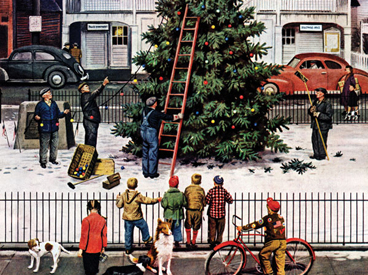
Church Christmas Tree
Stevan Dohanos
December 27, 1952
Grateful for the studded snow tires that anchor my car to the frozen earth, I follow the old dirt road as it crosses an icy creek, then winds through the snowy woods that extend for miles through the Vermont mountains.
It’s an incredibly beautiful day. Spotting the simple, 200-year-old Quaker meetinghouse in a sunny clearing ahead, I carefully slow to pull off the road, then stop by the freshly plowed path to its door.
To the north, there’s the sound of wood being chopped. To the east, a dog barks. But here there is only silence. As it has for nearly two centuries, this simple country church sits in a profound stillness rich with a sense of Presence. Leaning back in the sun, I relax for the first time in weeks.
This is my favorite time of year. My car is loaded with freshly cut pine boughs, candles, baskets of pine cones, dried seed pods, and lemon balm, plus garlands of balsam that I’ll use to drape over the door and decorate the deep windowsills of the old meetinghouse. But as I sit here in the warm sun, the rich fragrances of woods and meadow hold me in my seat—and remind me of the joyful blessings that will be woven into my life over the next several weeks.
1. The Blessing of Community

Tree in Town Square
Stevan Dohanos
December 4, 1948
During the holiday season, the entire world seems in harmony: Christians celebrate the birth of Jesus, Buddhists remember the enlightenment of Siddhartha, Jews recall the miraculous temple lamp that burned for eight days, Muslims welcome the new year based on the lunar calendar, and even nontheists join the expression of goodwill with colored lights and electric Santas that wave to passersby.
Down the mountain in the village of Bristol, the Christmas season begins on the first Saturday of December when villagers sweep the snow from their steps, light the village Christmas tree, and members of three churches around the village green hold their annual Christmas Bazaars.
“It looks like an old-fashioned Christmas card,” chuckles my friend Laurie Kroll. “Wreaths and greens are everywhere. St. Ambrose has a silver tea on one side of the green, First Baptist has soups and sandwiches for lunch on the other side, and the Federated Church around the corner has Santa.”
The members of each church have been knitting and baking for weeks to produce an abundance of foods and crafts, and each church becomes a small marketplace with tables of homemade jams and pickles, knitted hats, fruit-studded braided breads, and every kind of holiday ornament imaginable. It’s a fundraiser, sure—”One year we made enough to buy a new vacuum,” Laurie remembers—but more than that, it’s a time of coming together and remembering what we share.
2. The Blessing of Giving
Thinking about my friends in Bristol, I realize that there are probably few of us who won’t admit that gift-giving has strayed far from its humble beginnings of homemade crafts and food—particularly when we have to cart piles of wrapping paper and plastic packaging to the recycling center after Christmas or pay our credit card bills in January.
A few years ago, this really got to ecology author and activist Bill McKibben, who lives a few hills over from me near Ripton. “A bunch of us in what was then the Troy conference of the Methodist Church, were thinking that there was a lot of waste at Christmastime—all those batteries!” Bill recently messaged me. “But when we started talking with folks about new ways of celebrating Xmas, we quickly found out that there was something deeper here. People really dreaded the approach of Christmas, because it had all become too much—and they were incredibly receptive to the idea of doing it differently, with an emphasis on gifts of service.”
Bill and his friends persuaded a number of families to commit themselves to doing things for those with whom they normally exchanged gifts—walking an elderly aunt’s dog when the temperature drops into the single digits, for example. Bill subsequently wrote a book called Hundred Dollar Holiday, in which he proposed spending no more than $100 per family at Christmas. The result? Less running back and forth to the mall, less time spent desperately looking for hot toys and sales, less time tuned out with electronics—and more time spent sitting by the fire with family, sharing a potluck with friends, or taking a long walk outside, alone in the freshly fallen snow.
Become a Saturday Evening Post member and enjoy unlimited access. Subscribe now



